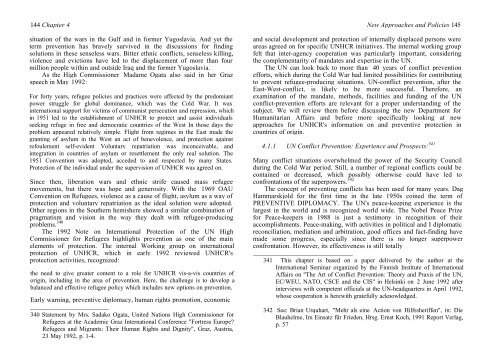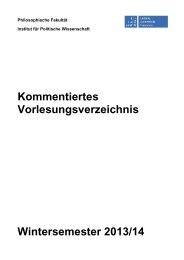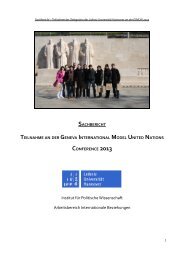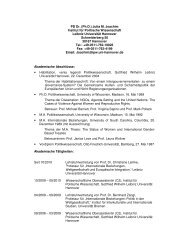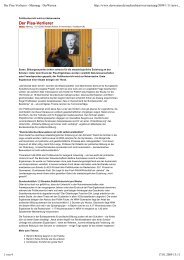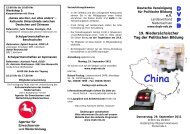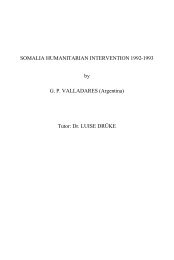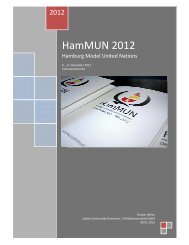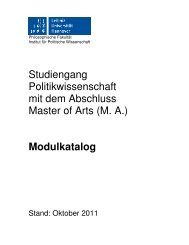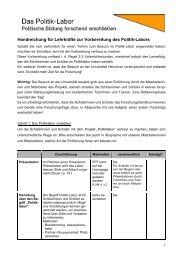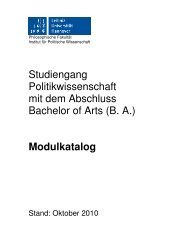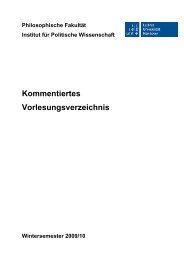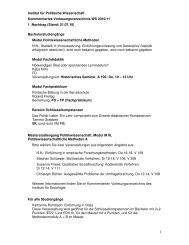Preventive Action for Refugee Producing Situations
Preventive Action for Refugee Producing Situations
Preventive Action for Refugee Producing Situations
You also want an ePaper? Increase the reach of your titles
YUMPU automatically turns print PDFs into web optimized ePapers that Google loves.
144 Chapter 4<br />
situation of the wars in the Gulf and in <strong>for</strong>mer Yugoslavia. And yet the<br />
term prevention has bravely survived in the discussions <strong>for</strong> finding<br />
solutions in these senseless wars. Bitter ethnic conflicts, senseless killing,<br />
violence and evictions have led to the displacement of more than four<br />
million people within and outside Iraq and the <strong>for</strong>mer Yugoslavia.<br />
As the High Commissioner Madame Ogata also said in her Graz<br />
speech in May 1992:<br />
For <strong>for</strong>ty years, refugee policies and practices were affected by the predomiant<br />
power struggle <strong>for</strong> global dominance, which was the Cold War. It was<br />
international support <strong>for</strong> victims of communist persecution and repression, which<br />
in 1951 led to the establishment of UNHCR to protect and assist individuals<br />
seeking refuge in free and democratic countries of the West In those days the<br />
problem appeared relatively simple. Flight from regimes in the East made the<br />
granting of asylum in the West an act of benevolence, and protection against<br />
refoulement self-evident Voluntary repatriation was inconceivable, and<br />
integration in countries of asylum or resettlement the only real solution. The<br />
1951 Convention was adopted, acceded to and respected by many States.<br />
Protection of the individual under the supervision of UNHCR was agreed on.<br />
Since then, liberation wars and ethnic strife caused mass refugee<br />
movements, but there was hope and generosity. With the 1969 OAU<br />
Convention on <strong>Refugee</strong>s, violence as a cause of flight, asylum as a way of<br />
protection and voluntary repatriation as the ideal solution were adopted.<br />
Other regions in the Southern hemishere showed a similar combination of<br />
pragmatism and vision in the way they dealt with refugee-producing<br />
problems. 340<br />
The 1992 Note on International Protection of the UN High<br />
Commissioner <strong>for</strong> <strong>Refugee</strong>s highlights prevention as one of the main<br />
elements of protection. The internal Working group on international<br />
protection of UNHCR, which in early 1992 reviewed UNHCR's<br />
protection activities, recognized:<br />
the need to give greater content to a role <strong>for</strong> UNHCR vis-a-vis countries of<br />
origin, including in the area of prevention. Here, the challenge is to develop a<br />
balanced and effective refugee policy which includes new options on prevention.<br />
Early warning, preventive diplomacy, human rights promotion, economic<br />
_______________________<br />
340 Statement by Mrs. Sadako Ogata, United Nations High Commissioner <strong>for</strong><br />
<strong>Refugee</strong>s at the Academic Graz International Conference "Fortress Europe?<br />
<strong>Refugee</strong>s and Migrants: Their Human Rights and Dignity", Graz, Austria,<br />
23 May 1992, p. 1-4.<br />
New Approaches and Policies 145<br />
and social development and protection of internally displaced persons were<br />
areas agreed on <strong>for</strong> specific UNHCR initiatives. The internal working group<br />
felt that inter-agency cooperation was particularly important, considering<br />
the complementarity of mandates and expertise in the UN.<br />
The UN can look back to more than 40 years of conflict prevention<br />
ef<strong>for</strong>ts, which during the Cold War had limited possibilities <strong>for</strong> contributing<br />
to prevent refugee-producing situations. UN-conflict prevention, after the<br />
East-West-conflict, is likely to be more successful. There<strong>for</strong>e, an<br />
examination of the mandate, methods, facilities and funding of the UN<br />
conflict-prevention ef<strong>for</strong>ts are relevant <strong>for</strong> a proper understanding of the<br />
subject. We will review them be<strong>for</strong>e discussing the new Department <strong>for</strong><br />
Humanitarian Affairs and be<strong>for</strong>e more specifically looking at new<br />
approaches <strong>for</strong> UNHCR's in<strong>for</strong>mation on and preventive protection in<br />
countries of origin.<br />
4.1.1 UN Conflict Prevention: Experience and Prospects: 341<br />
Many conflict situations overwhelmed the power of the Security Council<br />
during the Cold War period. Still, a number of regional conflicts could be<br />
contained or decreased, which possibly otherwise could have led to<br />
confrontations of the superpowers. 342<br />
The concept of preventing conflicts has been used <strong>for</strong> many years. Dag<br />
Hammarskjold <strong>for</strong> the first time in the late 1950s coined the term of<br />
PREVENTIVE DIPLOMACY. The UN's peace-keeping experience is the<br />
largest in the world and is recognized world wide. The Nobel Peace Prize<br />
<strong>for</strong> Peace-keepers in 1988 is just a testimony in recognition of their<br />
accomplishments. Peace-making, with activities in political and I diplomatic<br />
reconciliation, mediation and arbitration, good offices and fact-finding have<br />
made some progress, especially since there is no longer superpower<br />
confrontation. However, its effectiveness is still totally<br />
________________________________<br />
341 This chapter is based on a paper delivered by the author at the<br />
International Seminar organized by the Finnish Institute of International<br />
Affairs on "The Art of Conflict Prevention: Theory and Praxis of the UN,<br />
EC/WEU, NATO, CSCE and the CIS" in Helsinki on 2 June 1992 after<br />
interviews with competent officials at the UN-headquarters in April 1992,<br />
whose cooperation is herewith gratefully acknowledged.<br />
342 See: Brian Urquhart, "Mehr als eine <strong>Action</strong> von Hilfssheriffen", in: Die<br />
Blauhelme, Im Einsatz für Frieden, Hrsg. Ernst Koch, 1991 Report Verlag,<br />
p. 57


